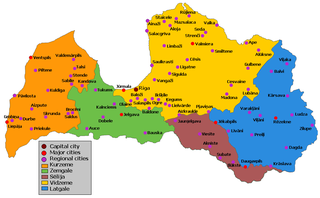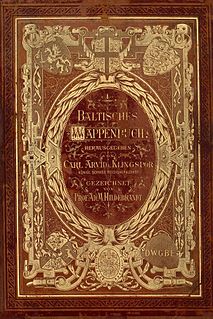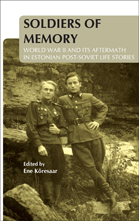
Baltic Germans were ethnic German inhabitants of the eastern shores of the Baltic Sea, in what today are Estonia and Latvia. Since their coerced resettlement in 1939, Baltic Germans have markedly declined as a geographically determined ethnic group. However, it is estimated that several thousand people with some form of (Baltic) German identity still reside in Latvia and Estonia.

Courland is one of the Historical Latvian Lands in western Latvia. The largest city is Liepāja, the third largest city in Latvia. The regions of Semigallia and Selonia are sometimes considered as part of Courland as they were formerly held by the same duke.

The United Baltic Duchy, or alternatively the "Grand Duchy of Livonia", was the name proposed during World War I by leaders of the local Baltic German nobility for a new monarchical state which, however, never came into existence. The unsuccessful attempt to establish a new German client state on the territory of what is now Latvia and Estonia was made in 1918, during the German occupation of the former Courland, Livonian, and Estonian governorates of the Russian Empire which had ceased to exist after the Bolshevik coup in 1917. The unsuccessful proclamation of a pro-German duchy was first made in April 1918, after the Republic of Estonia had already formally declared full independence from the warring Russian and German Empires.

The Baltic states of Estonia, Latvia and Lithuania were invaded and occupied in June 1940 by the Soviet Union, under the leadership of Stalin and auspices of the Molotov-Ribbentrop Pact that had been signed between Nazi Germany and the USSR immediately before the outbreak of World War II. The three countries were then annexed into the Soviet Union as constituent republics in August 1940, though the United States and most other Western countries never recognised this incorporation, considering it illegal. On 22 June 1941, Nazi Germany attacked the Soviet Union and within weeks occupied the Baltic territories. In July 1941, the Third Reich incorporated the Baltic territory into its Reichskommissariat Ostland. As a result of the Red Army's Baltic Offensive of 1944, the Soviet Union recaptured most of the Baltic states and trapped the remaining German forces in the Courland pocket until their formal surrender in May 1945.

Baltic German nobility was a privileged social class in the territories of today's Estonia and Latvia. It existed continuously since the Northern Crusades and the medieval foundation of Terra Mariana. Most of the nobility were Baltic Germans, but with the changing political landscape over the centuries, Polish, Swedish and Russian families also became part of the nobility, just as Baltic German families re-settled in locations such as the Swedish and Russian Empires. The nobility of Lithuania is for historical, social and ethnic reasons often separated from the German-dominated nobility of Estonia and Latvia.

On the Boundary of Two Worlds: Identity, Freedom, and Moral Imagination in the Baltics is an academic book series focused on the critical examination of identity, politics, and culture in the Baltic countries. By offering a wide scope of the social science and humanities disciplines, the book series encourages intercultural dialogue and pursues interdisciplinary research in the field of Baltic studies.
Hajo Holborn was a German-American historian and specialist in modern German history.

The Duchy of Courland and Semigallia was the name for a proposed client state of the German Empire during World War I which did not come into existence. It was proclaimed on 8 March 1918, in the German-occupied Courland Governorate by a council composed of Baltic Germans, who offered the crown of the once-autonomous duchy to Kaiser Wilhelm II, despite the existence of a formerly sovereign reigning family in that duchy, the Biron descendants of Ernst Johann von Biron. Although the German Reichstag supported national self-determination for the peoples of the Baltic provinces, the German High Command continued the policy of attaching these territories to the German Reich by relying on the local Baltic Germans.

Krzysztof Jan Skubiszewski(listen) was a Polish politician, a former Minister of Foreign Affairs (1989–1993) and an established scholar in the field of international law.

The three Baltic states – Estonia, Latvia, and Lithuania – are held to have continued as legal entities under international law while under Soviet rule and German occupation from 1940 to 1991. The prevailing opinion accepts the Baltic thesis of illegal occupation and the actions of the USSR are regarded as contrary to international law in general and to the bilateral treaties between the USSR and the Baltic states in particular.

Estonia was under military occupation by the German Empire during the later stages of the First World War. On 11–21 October 1917, the Imperial German Army occupied the West Estonian archipelago, including the larger islands of Saaremaa (Ösel), Hiiumaa (Dagö), and Muhu (Moon).

The Welles Declaration was a diplomatic statement issued on July 23, 1940, by Sumner Welles, the acting US Secretary of State, condemning the June 1940 occupation by the Soviet Union of the three Baltic states and refusing to recognize their annexation as Soviet republics. It was an application of the 1932 Stimson Doctrine of nonrecognition of international territorial changes that were executed by force and was consistent with US President Franklin Roosevelt's attitude towards violent territorial expansion.

The background of the occupation of the Baltic states covers the period before the first Soviet occupation on 14 June 1940, stretching from independence in 1918 to the Soviet ultimatums in 1939–1940. Lithuania, Latvia, and Estonia gained independence in the aftermath of the Russian revolutions of 1917 and the German occupation which in the Baltic countries lasted until the end of World War I in November 1918. All three countries signed non-aggression treaties with the Soviet Union in the 1920s and 1930s. Despite the treaties, in the aftermath of the 1939 German–Soviet pact, Estonia, Latvia and Lithuania were occupied, and thereafter forcibly incorporated into the Soviet Union, in 1940.

These Baltic states were under Soviet rule from the end of World War II in 1945, from Sovietization onwards until independence was regained in 1991. The Baltic states were occupied and annexed, becoming the Soviet socialist republics of Estonia, Latvia and Lithuania. After their annexation by Nazi Germany, the USSR reoccupied the Baltic territories in 1944 and maintained control there until the Baltic states regained their independence nearly 50 years later in the aftermath of the Soviet coup of 1991.

The Soviet Union occupied most of the territory of the Baltic states in its 1944 Baltic Offensive during World War II. The Red Army regained control over the three Baltic capitals and encircled retreating Wehrmacht and Latvian forces in the Courland Pocket where they held out until the final German surrender at the end of the war. The German forces were deported and the leaders of Latvian collaborating forces were executed as traitors. After the war, the Baltic territories were reorganized into constituent republics of the USSR until they declared independence in 1990 amid the collapse of the Soviet Union.

The Committee of the German-Baltic Parties was an alliance of Baltic German political parties in Latvia during the inter-war period. Its members included the German-Baltic Democratic Party, the German-Baltic Progressive Party, the German-Baltic Reform Party, the German-Baltic People's Party, the German-Baltic Integration Party, the German-Baltic State Party and the Voters Association of Mitau.

Seminar Studies in History is a long-running book series for undergraduate and younger students that aims to bridge the gap between the monograph and the full size university textbook. The series was established by history teacher Patrick Richardson and was one of the first series of academic history books to include documentary sources as standard.
V. Martyn Housden is reader in modern history at the University of Bradford. Housden's research interests relate to the history of refugees, Fridtjof Nansen, the League of Nations, the psychoanalysis of Erich Fromm, the history of national minorities, and the history of Germany.
The Warsaw Accord was signed on 17 March 1922 by Finland, Poland, Estonia and Latvia, but failure by the Parliament of Finland to ratify it made it never enter into force.











